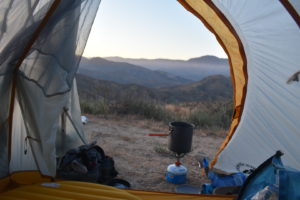
When it comes to spending time in the backcountry, picking out the right gear is essential. With so many different options out there, trying to find the right tent can be a hassle. That’s why I want to help you narrow down some choices so you can find something that will increase comfort, safety and enjoyment on your backcountry trips.
I’ve personally spent hundreds of days in the backcountry, observing, researching and testing all of the top-notch tents that are out there today. I’ve narrowed down a list of the Top 5 Backpacking Tents of 2020!
For more of our favorite gear recommendations, take a look at some of these other popular Epic Reviews, such as:
- Altra Lone Peak Review: The Best Trail Running Shoe That’s Not Just For Running
- Osprey Atmos AG Series Review: A Backpack That Can Do It All
- Down vs. Synthetic Sleeping Bags: Which Is Right For You?
- Ruffwear Palisades Dog Pack Review: A Backpack Your Dog Will Love!
- Salewa Alp Trainer Mid GTX Hiking Boot Review: Best Boot I’ve Tried!
What To Look For In A Tent?
When I’m looking for a new tent, there are basically four major things I’m looking for. Whether you’re looking for a tent to haul off into the backcountry, or just an ordinary camping tent, these factors all play a role.
- Durability & Weather Protection – Look, we all know we aren’t in control of the weather. There’s no telling what mother nature will decide to throw at us on our next backcountry adventure. One thing we do have control over is whether we’re prepared or not. So looking at the construction of the tent is going to be one of the first things I look at. A thicker, stronger material with sturdier poles will without a doubt add a bit of extra weight, but what does it matter if it adds to the overall enjoyment of your trip.
- Weight – I’m going to be hauling this thing for many days, maybe over multiple mountain passes. Now I don’t necessarily fall under the “ultra-light backpacker” category. I carry what I need based on the environment I’m hiking in and factoring in all things that could possibly go wrong. But, with that being said, having useless weight can be a real challenge when taking those first steps on your multi-day backpack and realizing there are a few things you could have done to make yourself more comfortable, but didn’t.
- Space – You’ll want a spacious backpacking tent to ensure a bit of comfort while at camp. There’s no worse feeling than setting up camp only to find out that a massive storm comes rolling in, and realizing that your pack and gear doesn’t fit inside the tent with you, as well as the fact that you are stuck in one position for the remainder of the storm. I understand we are out there to ruff it and “we’re too grunge” to care about comfort, but trust me on this. You’ll thank yourself later!
- Price – Here’s the hard part. Paying for the thing. I know, I know.. Most of these bad boys aren’t cheap. We go through all the specs and its features, coming to find out that this is the tent we’ve been searching for, only to find that it costs an arm and a leg. Well, let’s put it this way.. If you found a vacation home that guarantees comfort and protection, whenever and wherever you want to go. And, if properly taken care of, can last up to 5-10 years. I think that’d be a fair way to justify your purchase. Wouldn’t you?

How Do I Choose the Right Size Tent?
In reality, when it comes to tent sizes, most manufacturers exaggerate a bit on how many people can fit in them, “comfortably”. I’m about 6’2, and if I was to choose a 1-person tent, I wouldn’t be that comfortable. So I always use a 2-person tent for myself. I could make it work with a 1-person, but there’s no way I’m fitting myself and all my gear in there with me. Sure, I could use the vestibule to store my gear, but again, I personally find it easier and more convenient to just have it in the tent with me so I’m not constantly working the tent zipper every time I need something.
If I was planning on sleeping 2 people in one tent, I would consider carrying a 3 person tent and just splitting the weight amongst the two of you. Not everyone will agree with that, for weight purposes, but this is just a suggestion for you to consider.

Huge Spring Sale on gear. Check out the link below! (Free Shipping over $40 + no sales tax!)
USOUTDOOR.com Sale! Save up to 70% off Outdoor Gear & Apparel
5 Best Backpacking Tents of 2020
Big Agnes Copper Spur HV UL
BEST OVERALL TENT FOR WEIGHT, SPACE, AND QUALITY
MSRP (UL2): $294.97 (Discounted)
MEASURED WEIGHT (UL2): 3 lb. 1 oz.
DIMENSIONS (L x W x H): 88 x 52/42 x 40 in. (wider at head, narrower at foot)
SIZES: 1P, 2P, 3P, & 4P, 2P Platinum, & 3P Platinum
PROS: Ultralight, roomy interior, quick & easy to pitch, great pockets, large doors & vestibules, quality construction & materials, freestanding
CONS: Slightly less durable than some tents, rainfly zippers can snag, a bit pricy
BOTTOM LINE: I believe the Big Agnes Copper Spur HV UL2 and UL3 have the best combination of weight, interior space, weather protection, and ease-of-use of any backpacking tent on the market. This tent may be a little pricy for some, but you’ll find it difficult to come across a better freestanding backpacking tent in this weight class.
If you’re okay with a tighter interior or you often backpack solo, the UL2 is an excellent choice. If you mostly backpack in pairs, I’d suggest bumping up to the UL3, which has more interior space and only weighs 13 ounces more.
Nemo Hornet 2
ULTRALIGHT 1-PERSON TENT WITH INTERIOR SPACE & SMALL PACKED SIZE
MSRP: $369.95
MEASURED WEIGHT: 2 lb. 4.9 oz.
DIMENSIONS (L x W x H): 85 x 51/43 x 40 in. (wider at head, narrower at foot)
SIZES: 1P, 2P, Elite 1P, & Elite 2P
PROS: Ultralight, 2 doors/vestibules, good space for a solo hiker, small packed size
CONS: Semi-freestanding, not really enough space for 2, short for hikers over 6 ft. tall
BOTTOM LINE: The NEMO Hornet 2 is an incredibly light double-wall, semi-freestanding tent. It has two doors and vestibules, which is a rare benefit for a tent in its weight class. It’s listed as a 2-person tent, but the slanted walls limit interior space and make it a tight squeeze for two. I feel that the Hornet 2 makes a better solo backpacking shelter for those who like to have enough space to keep their gear inside. The Hornet’s main drawback is its semi-freestanding design (it requires two stakes at the foot), which can be inconvenient in rocky terrain and wet/windy weather. Overall, if you’re a solo ultralight backpacker looking for all the comforts of a traditional tent, the Hornet 2P is a great option.
MORE: The Hornet also comes in “Elite” model sizes (links above), which are slightly lighter but cost more. I think the standard 2P version used as a solo shelter delivers the best value. Pick up the Hornet 2 footprint if you want to increase tent floor durability.
Big Agnes Fly Creek HV UL 2
MSRP: $349.95
MEASURED WEIGHT: 2 lb. 4.5 oz.
DIMENSIONS (L x W x H): 86 x 52/42 x 40in (wider at head, narrower at foot)
SIZES: 1P, 2P, 3P, 1P Platinum, & 2P Platinum
PROS: Ultralight, small packed size
CONS: Semi-freestanding, front entry can be inconvenient, 1 small vestibule, not enough interior space for 2
BOTTOM LINE: The Big Agnes Fly Creek HV UL2 is among the lightest double-wall, semi-freestanding tents on the market. It has a similar floor plan to the Nemo Hornet 2P (both actually work best as 1-person tents in our opinion), but unlike the Hornet, The Fly Creek only has one door and vestibule, which limits its livability.
MORE: The Platinum version of this tent is lighter, but it’s more expensive and uses thinner materials.. In my opinion, the regular 2P version used as a solo shelter provides the best value. Pick up the Fly Creek UL2 Footprint if you want to increase tent floor durability.
MSR Hubba Hubba Hubba NX
LIGHTWEIGHT LIVABILITY, DURABILITY, & WEATHER PROTECTION
MSRP: $449.95
MEASURED WEIGHT: 3 lb. 14.1 oz.
DIMENSIONS (L x W x H): 84 x 50 x 39 in.
PROS: Double-Wall, 2 doors/vestibules, freestanding, durable, roomy
CONS: Slightly heavy for solo trips, side walls feel a bit close at head of tent
BOTTOM LINE: The MSR Hubba Hubba NX has been one of the most popular tents in the backpacking world for many years, and with good reason. It’s a well designed, roomy, and durable tent that provides excellent protection in windy and wet weather. The symmetrical layout and near vertical sidewalls on the Hubba Hubba provide a lot of interior space for two hikers to sit up and hang out. My two main complaints with the Hubba Hubba are that it’s a tad heavier than I prefer, though not bad when split between two hikers, and the wall at the head feels a bit close to the face while lying down. Overall, the Hubba Hubba ranks squarely among the best backpacking tents for dependable protection and comfort.
Marmot Tungsen 2P UL
BUDGET-FRIENDLY LIGHTWEIGHT TENT WITH LIVABLE INTERIOR SPACE
MSRP: $241
MEASURED WEIGHT: 3 lb. 10.8 oz.
DIMENSIONS (L x W x H): 88 x 54/46 x 42 in. (wider at head, narrower at foot)
PROS: Affordable, roomy interior, freestanding, 2 doors/vestibules, quick & easy to pitch
CONS: A little heavier than some, one vestibule is smaller than the other
BOTTOM LINE: The Marmot Tungsten 2P UL strikes a great balance between weight, cost, and livability. In our eyes this is a highly underrated backpacking tent. It has a similar floor plan to the Copper Spur HV UL2 and MSR Hubba Hubba NX, but comes at a lower cost and feels roomier inside. We like that its polyester rainfly doesn’t sag in wet/cold weather and it’s door zippers open easily with one hand. My main complaint with the Tungsten is that it’s two side vestibules aren’t symmetrical (one is larger than the other for some reason). Still, for its weight, cost, and interior space, the Marmot Tungsten 2P UL squarely ranks among the best.
MORE: Pick up the 2P UL footprint if you want to increase tent floor durability.
Do I really Need a Footprint?
Nowadays, most tents don’t come with a footprint and many of the ultralight backpackers view them as unnecessary. The main benefit of using a footprint is to add durability to the floor of your tent, as well as the longevity of its life. The footprint will protect your floor from abrasion and will require fewer repairs. Plus, what’s a few extra ounces if it is going to take care of your nice (probably expensive) tent?
*Editor’s note: Help support this site by making your next gear purchase through one of the links above. Click a link, buy what you need, and the seller will contribute a portion of the purchase price to support TheEpicReviews unsponsored gear reviews, articles, and hiking guides.






